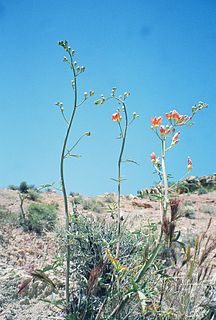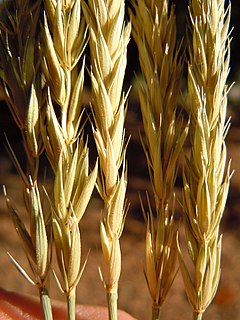
Oryzopsis hymenoides is a cool-season, perennial bunchgrass with narrow, rolled leaf blades. It is native to western North America east of the Cascades from British Columbia and Alberta south to southern California, northeastern Mexico, and Texas.

Ammophila arenaria is a species of flowering plant in the grass family Poaceae. It is known by the common names marram grass and European beachgrass. It is one of two species of the genus Ammophila. It is native to the coastlines of Europe and North Africa where it grows in the sands of beach dunes. It is a perennial grass forming stiff, hardy clumps of erect stems up to 1.2 metres (3.9 ft) in height. It grows from a network of thick rhizomes which give it a sturdy anchor in its sand substrate and allow it to spread upward as sand accumulates. These rhizomes can grow laterally by 2 metres in six months. One clump can produce 100 new shoots annually.

Swallenia is a rare genus of plants in the grass family, found only in Death Valley National Park, California.

Coleogyne ramosissima or blackbrush, is a low lying, dark grayish-green, aromatic, spiny, perennial, soft wooded shrub, native to the deserts of the southwestern United States. It is called blackbrush because the gray branches darken when wet by rains. It is in the rose family (Rosaceae), and is the only species in the monotypic genus Coleogyne.

Festuca idahoensis is a species of grass known by the common names Idaho fescue and blue bunchgrass. It is native to western North America, where it is widespread and common. It can be found in many ecosystems, from shady forests to open plains grasslands.

Carex nebrascensis is a species of sedge known as Nebraska sedge.

Carex pansa is a species of sedge known by the common name sand dune sedge. It is native to coast of western North America from British Columbia to California, where it grows in dunes and other sandy habitat. This grasslike sedge produces sharply triangular stems up to about 40 centimeters tall from a network of thin, long, coarse rhizomes. The inflorescence is a cluster of several spikes of dark brownish flowers. The plant sometimes produces only male or female flowers in its inflorescences, but not both. This sedge is sometimes used as a grass substitute in local landscaping schemes.

Sphaeralcea gierischii, Gierisch's globemallow or Gierisch mallow, is an endangered species of flowering plant in the mallow family, Malvaceae. It is native to the western United States, where it is known only from Utah and Arizona. It was described in 2002.

Hilaria is a genus of North American plants in the grass family. Members of the genus are commonly known as curly mesquite. They are found in the Southwestern United States, Mexico, and Guatemala.

Oenothera californica, known by the common name California evening primrose, is a species of flowering plant in the evening primrose family.

Hilaria jamesii is a species of grass known by the common name James' galleta.

Calamagrostis montanensis is a species of grass known by the common names plains reedgrass and prairie reedgrass. It is native to North America, where it is found across Canada from British Columbia to Manitoba and south to Colorado in the United States.

Panicum repens is a species of grass known by many common names, including torpedograss, creeping panic, panic rampant, couch panicum, wainaku grass, quack grass, dog-tooth grass, and bullet grass. Its exact native range is obscure. Sources suggest that the grass is native to "Africa and/or Asia", "Europe or Australia", "Eurasia", "Australia", "Europe, Asia, and Africa", or other specific regions, including the Mediterranean, Israel, and Argentina. It is present in many places as an introduced species and often a noxious weed. It has been called "one of the world's worst weeds."

Hilaria mutica, synonym Pleuraphis mutica, is a species of grass known by the common name tobosa, or tobosa grass. It is native to Northern Mexico, and the Southwestern United States, in Arizona, New Mexico, Oklahoma, and Texas.

Psathyrostachys juncea is a species of grass known by the common name Russian wildrye. It was formerly classified as Elymus junceus. It is native to Russia and China, and has been introduced to other parts of the world, such as Canada and the United States. Psathyrostachys juncea is a great source of food for grazing animals, as it has high nutrition value in its dense basal leaves, even in the late summer and autumn seasons. This species can grow and prosper in many harsh environments, making it an ideal candidate for improvement as it can grow in areas were farming is difficult. This species is a drought-resistant forage plant and can survive during the cool seasons. It is also a cross-pollinator and is self-sterile. This means that P. juncea cannot self-fertilize; it must find another plant of the same species with which to exchange gametes. Self-sterilization increases the genetic diversity of a species.

Panicum amarum is a species of grass known by the common name bitter panicum. It is native to North America, where it is found in coastal regions along the East Coast and Gulf Coast of the United States and into northeastern Mexico. It also occurs in The Bahamas and in Cuba.
Eremocrinum is a monotypic genus of plants in the subfamily Agavoideae containing the single species Eremocrinum albomarginatum. It is known by the common names Utah solitaire lily, Intermountain false-wheatgrass, desert lily, lonely lily, and sand lily. It is native to the western United States, where it is known from Arizona and Utah.
The flora of the Colorado Plateau and Canyonlands region of the Western United States.

Carex eburnea, known as ivory sedge, ebony sedge, and bristleleaf or bristle-leaved sedge, is a small and slender sedge native to North America, from Alaska and Newfoundland south to central Mexico.

















